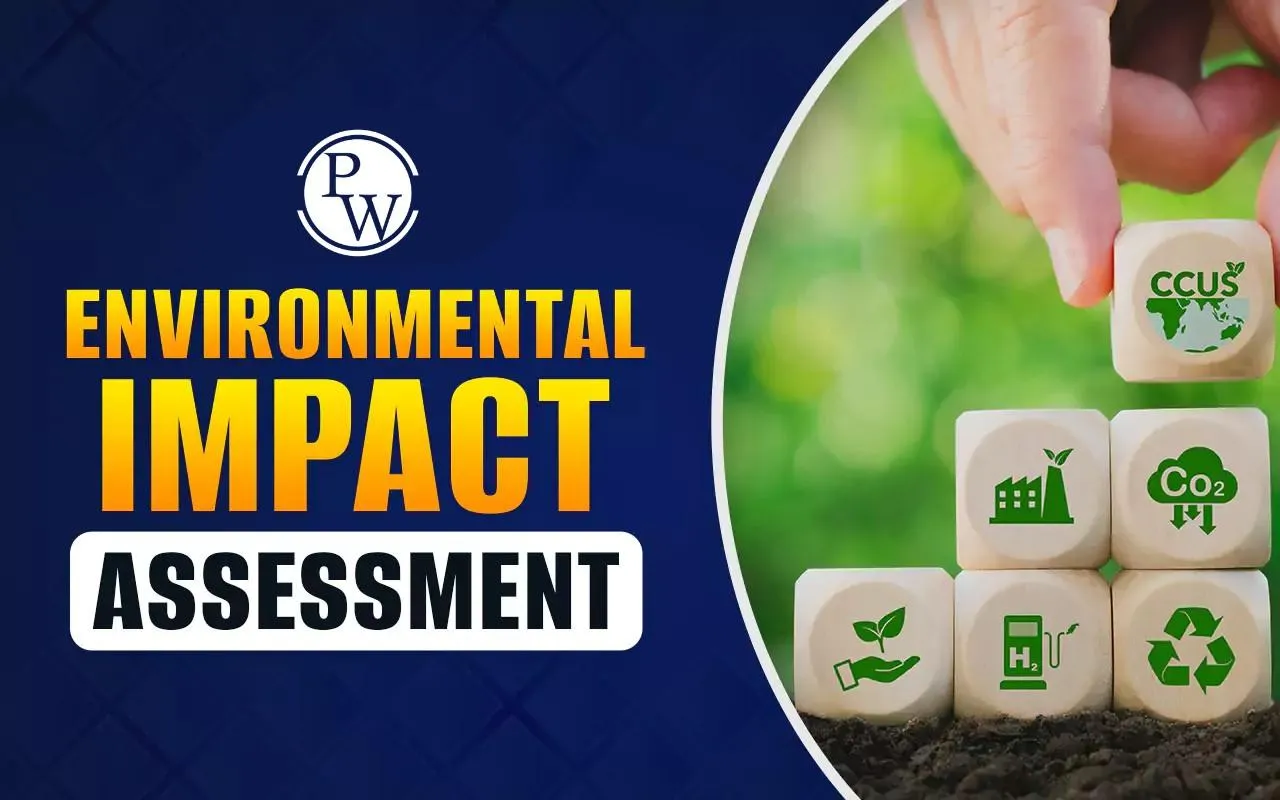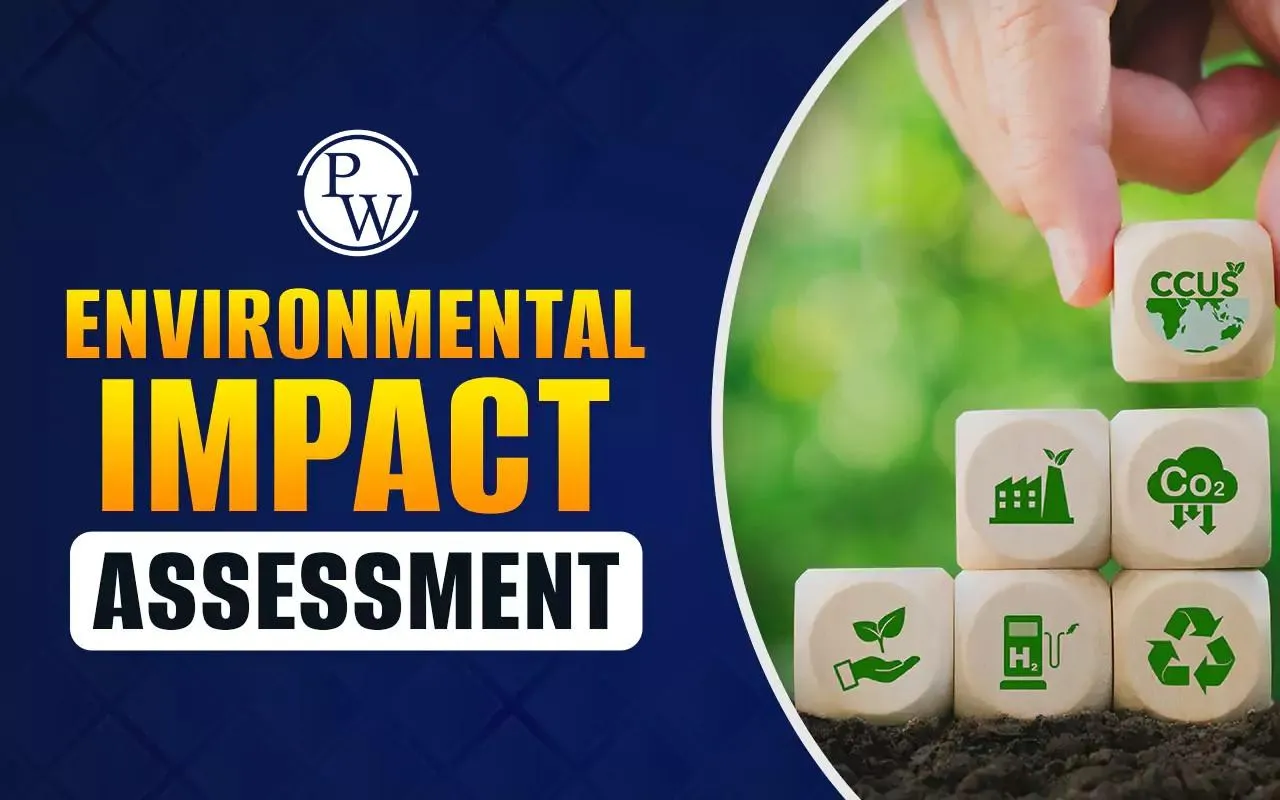Environmental Impact Assessment refers to the process of predicting and reducing the effects of projects on nature. It helps in the protection of air, water, soil, and wildlife while also taking care of sustainable development. Proper EIA ensures safer, eco-friendly and legally compliant developmental projects.


Environmental Impact Assessment: The activity of each and every human being in the country affects the environment in some way. Construction, industries, mining, and roads can change the land, air, water, and wildlife. To prevent any damage to the environment and ensure sustainable development, governments use a tool called Environmental Impact Assessment (EIA).
Environmental Impact Assessment (EIA) helps to predict the effects of a project on nature before it begins. It guides decision-makers to take steps that protect the environment while allowing development to continue.
What is Environmental Impact Assessment (EIA)?
Environmental Impact Assessment is the process used to evaluate the potential effects of a proposed developmental project on the environment. It identifies both positive and negative impacts and suggests ways to minimise the associated damages. Some of the key points related to Environmental Impact Assessment UPSC are as follows:
-
EIA predicts how a project may affect air, water, soil, plants, and animals.
-
It helps the government decide if a project should proceed.
-
EIA ensures projects are environmentally safe and socially acceptable.
-
It is used in industries, highways, power plants, dams, and urban development.
-
Early planning reduces risks and long-term costs for companies and communities.
Importance of EIA
Environmental Impact Assessment is important because it balances development with environmental protection. Without EIA, certain developmental projects could harm natural resources and human health. The importance of EIA can be gauged from the following:
-
Protects ecosystems: Prevents the destruction of forests, rivers, and wildlife.
-
Prevents pollution: Reduces air, water, and soil contamination.
-
Ensures public health: Helps avoid health hazards caused by industrial waste or emissions.
-
Supports sustainable growth: Allows development without exhausting natural resources.
-
Legal compliance: Helps projects follow national and international environmental laws.
-
Public involvement: Communities can voice concerns and suggest changes before a project starts.
Steps Involved in EIA
Several steps are followed under the Environmental Impact Assessment to properly analyse the efficiency of any project. The steps involved in the analysis of the Environmental Impact Assessment of a Project are as follows:
| Steps Involved in EIA | |
| Steps | Details |
| Screening |
|
| Scoping |
|
| Baseline Study |
|
| Impact Prediction |
|
| Mitigation Measures |
|
| Public Consultation |
|
| Final EIA Report |
|
| Monitoring |
|
Types of Environmental Impacts
Environmental Impact Assessment is a tool used to analyse the environmental sustainability of any large-scale project. It examines several impacts caused by human activities. These impacts can be short-term or long-term, local or widespread. The different types of environmental impacts are as follows:
| Types of Environmental Impacts | ||
| Impact Type | Details | Examples |
| Air Pollution | Release of harmful gases and dust | Smoke from factories |
| Water Pollution | Contamination of rivers, lakes, or groundwater | Effluent discharge from industries |
| Soil Degradation | Loss of fertile land or soil erosion | Mining activities |
| Noise Pollution | Harmful sound levels affect humans and animals | Construction of highways |
| Biodiversity Loss | Destruction of plants and animals | Deforestation for urban development |
| Social Impact | Effects on local communities | Relocation of villagers due to dams |
| Climate Impact | Changes in local climate patterns | Large-scale industrial projects are increasing greenhouse gases |
EIA Process and Methodology
The process of the Environmental Impact Assessment UPSC uses several scientific methods and analyses to assess environmental effects correctly. It combines data collection, modelling, and community feedback. Methods used in EIA include the following:
-
Field Surveys: Collecting data on air, water, soil, and wildlife.
-
Modelling: Predicts pollution levels, water flow, and ecosystem changes.
-
Laboratory Analysis: Tests samples for contaminants.
-
Risk Assessment: Estimates potential dangers to humans and animals.
-
Public Hearings: Gathers opinions from affected communities.
-
Cost-Benefit Analysis: Evaluates whether the benefits of the project are more than the environmental costs.
Role of Government and Regulations
Governments play a very significant role in ensuring that EIA is properly conducted for any developmental project. They set rules, approve projects, and monitor compliance. In India, the Ministry of Environment, Forest and Climate Change (MoEFCC) looks after the EIA for large infrastructure projects. The key responsibilities of the Government regarding EIA are as follows:
-
Legislation: Laws like the Environment Protection Act make EIA mandatory.
-
Approval: Authorities review EIA reports before granting permission.
-
Monitoring: Regular inspections ensure that mitigation measures are followed.
-
Public Awareness: Encourages community participation in decision-making.
-
International Standards: Ensures projects follow global environmental guidelines.
Advantages and Limitations of EIA
While EIA is a very important tool for protecting nature, it also has certain challenges. Understanding both sides helps improve environmental planning. The advantages and disadvantages of EIA are summarised in the table below:
| Advantages and Limitations of EIA | |
| Advantages | Limitations |
| Prevents environmental harm | Time-consuming process |
| Promotes sustainable projects | May lack complete data |
| Involves community participation | Needs strict government enforcement |
| Ensures legal compliance | Public feedback is not always considered |
| Encourages eco-friendly planning | Cannot predict all long-term effects |
Environmental Impact Assessment FAQs
What is Environmental Impact Assessment (EIA)?
EIA is a process used to predict and evaluate the effects of a proposed project on the environment, suggesting measures to reduce negative impacts.
Why is EIA important?
EIA balances development with environmental protection by preventing pollution, safeguarding ecosystems, ensuring public health, and supporting sustainable growth.
What are the main steps involved in EIA?
The key steps are screening, scoping, baseline study, impact prediction, mitigation measures, public consultation, final report, and monitoring.
Under which act is Environmental Impact Assessment (EIA) mandatory in India?
EIA is mandatory in India under the Environment (Protection) Act, 1986, and its procedures are outlined in the EIA Notification of 2006 issued by the Ministry of Environment, Forest and Climate Change (MoEFCC).
What is the purpose of an Environmental Impact Assessment?
The purpose of an EIA is to evaluate the potential environmental impacts of a proposed project before it begins, ensuring sustainable development and minimising harm to the environment.
Free Learning Resources
PW Books
Notes (Class 10-12)
PW Study Materials
Notes (Class 6-9)
Ncert Solutions
Govt Exams
Class 6th to 12th Online Courses
Govt Job Exams Courses
UPSC Coaching
Defence Exam Coaching
Gate Exam Coaching
Other Exams
Know about Physics Wallah
Physics Wallah is an Indian edtech platform that provides accessible & comprehensive learning experiences to students from Class 6th to postgraduate level. We also provide extensive NCERT solutions, sample paper, NEET, JEE Mains, BITSAT previous year papers & more such resources to students. Physics Wallah also caters to over 3.5 million registered students and over 78 lakh+ Youtube subscribers with 4.8 rating on its app.
We Stand Out because
We provide students with intensive courses with India’s qualified & experienced faculties & mentors. PW strives to make the learning experience comprehensive and accessible for students of all sections of society. We believe in empowering every single student who couldn't dream of a good career in engineering and medical field earlier.
Our Key Focus Areas
Physics Wallah's main focus is to make the learning experience as economical as possible for all students. With our affordable courses like Lakshya, Udaan and Arjuna and many others, we have been able to provide a platform for lakhs of aspirants. From providing Chemistry, Maths, Physics formula to giving e-books of eminent authors like RD Sharma, RS Aggarwal and Lakhmir Singh, PW focuses on every single student's need for preparation.
What Makes Us Different
Physics Wallah strives to develop a comprehensive pedagogical structure for students, where they get a state-of-the-art learning experience with study material and resources. Apart from catering students preparing for JEE Mains and NEET, PW also provides study material for each state board like Uttar Pradesh, Bihar, and others
Copyright © 2025 Physicswallah Limited All rights reserved.
Get App
